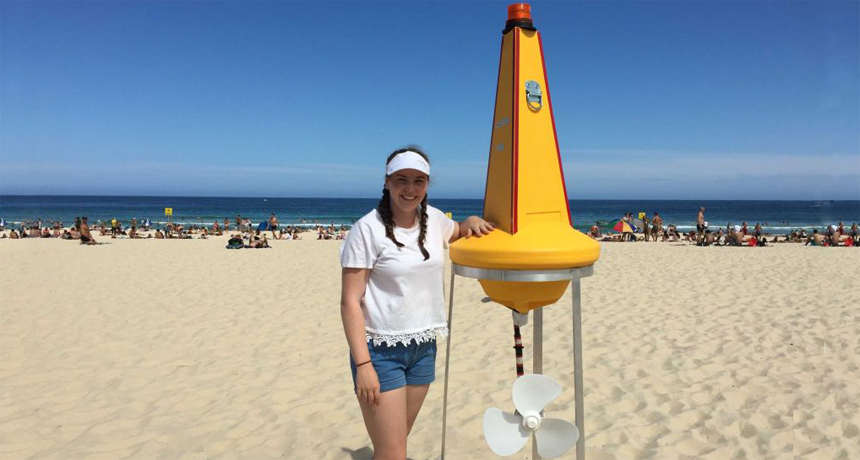Teen’s invention can warn of deadly rip currents
Called ‘Clever GIRL,’ this buoy lights up when waters flow too fast for swimmers

Clever GIRL’s Maddison King, 18, invented a buoy that can alert swimmers to dangerous currents known as rip currents. Here she's seen with an early prototype of her system.
King
Share this:
- Share via email (Opens in new window) Email
- Click to share on Facebook (Opens in new window) Facebook
- Click to share on X (Opens in new window) X
- Click to share on Pinterest (Opens in new window) Pinterest
- Click to share on Reddit (Opens in new window) Reddit
- Share to Google Classroom (Opens in new window) Google Classroom
- Click to print (Opens in new window) Print
By Sid Perkins
LOS ANGELES, Calif. — Want to know if where you’re planning to swim has strong, swift and dangerous currents? Just ask a Clever GIRL. A Clever Global Intelligent Rip Locator, that is. That’s the name 18-year-old Maddison King gave to her new invention. It can alert swimmers to potentially deadly waters containing what’s known as “rip currents.”
A 12th-grader at Meriden School in Strathfield, Australia, Maddison is also a lifeguard. So she knows the risks posed by these rip currents. They form after a wave breaks on shore and the water rushing back to sea now gets focused into a very narrow channel. That channel could be a slot in the rocks just offshore. Or, it could be a temporary gap in a mass of sand. Whatever its source, that focus makes water flow through the gap very quickly, notes Maddie.
When the flow exceeds 70 centimeters per second (about 1.6 miles per hour), most swimmers can’t fight their way back to shore. Swimmers can easily be carried up to 200 meters (an eighth of a mile) offshore. That’s a long way, especially for a panicked or inexperienced swimmer. It’s possible to escape rip currents by swimming along the shore rather than directly back toward the beach, she notes. But not everyone knows this.
So Maddie decided to develop a warning probe that could alert swimmers when rip currents are present. Clever GIRL could help save many lives, she suspects. In her country, for instance, rip currents are behind about 90 percent of all drownings at the beach. It also could help lifeguards: About 80 percent of the rescues they perform involve swimmers caught in rip currents.
Maddie has developed four different prototypes of her buoys. The first didn’t work well. The next three have included several improvements to boost its performance. The current model is plastic, filled with foam and a little bigger than a basketball. It can be secured to the ocean floor, or attached to others by a long chain (using the handles on each side of the buoy).
The teen showcased her latest buoy, here, at the Intel International Science and Engineering Fair (Intel ISEF). Created by Society for Science & the Public and sponsored by Intel, this competition lets students from around the world show off their winning science fair projects. (The Society also publishes Science News for Students and this blog.) This week, nearly 1,800 high school students from more than 75 countries competed for big prizes and to give visibility to their research projects.
Clever GIRL’s smarts are hidden below the surface. There, water flowing past the buoy drives a small propeller. It looks like the ones on many boats. Water traveling faster than 70 centimeters per second spins the propeller fast enough to trigger a warning light atop the buoy. Maddie made the light red, she explains, because the flash of a bright white light might be mistaken for reflecting sunlight.
Because the spinning propeller powers the warning light, her buoy needs no batteries. The current prototype cost Maddie about $300 to make. But if the devices were produced in large numbers, they might cost no more than $100 each, she says. Future versions might even include something like a warning siren. That would provide even better alerts to dangerous rip currents.
Because warning lights and sirens are easy to understand, even tourists that don’t speak the local language can recognize when they face danger, says Maddie. What’s more, she notes, if lifeguards didn’t have to spend so much time rescuing people caught in rip currents, they could focus more of their attention on other swimmers.







